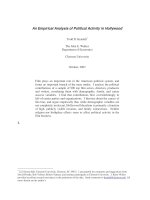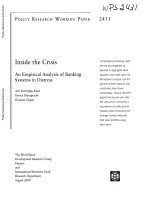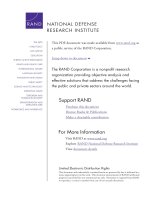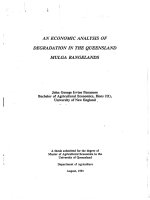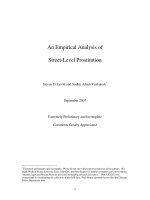PATENTS AND MEDICAL BIOTECHNOLOGY: AN EMPIRICAL ANALYSIS OF ISSUES FACING THE AUSTRALIAN INDUSTRY
Bạn đang xem bản rút gọn của tài liệu. Xem và tải ngay bản đầy đủ của tài liệu tại đây (842.21 KB, 290 trang )
PATENTS AND MEDICAL
BIOTECHNOLOGY: AN
EMPIRICAL ANALYSIS OF
ISSUES FACING THE
AUSTRALIAN INDUSTRY
DIANNE NICOL AND JANE
NIELSEN
CENTRE FOR LAW AND
GENETICS
OCCASIONAL PAPER No. 6
All rights reserved
Copyright ©2003 University of Tasmania, Dianne Nicol and Jane
Nielsen
Apart from fair dealing for the purposes of study, research, criticism
or review, as permitted under copyright law, no part of this
publication shall be reproduced by any process without written
permission of the owners of copyright. Inquiries should be made to
the authors or publisher.
National Library of Australia Cataloguing-in-Publication Data
ISSN 1445-2766
This issue may be cited as:
Centre for Law and Genetics Occasional Paper No. 6 (2003).
Published by
Centre for Law and Genetics Printed by
Faculty of Law UniPrint
University of Tasmania University of Tasmania
Private Bag 89 Private Bag 15
Hobart Tasmania 7001 Hobart Tasmania 7001
Australia Australia
i
TABLE OF CONTENTS
Preface viii
Abstract x
PART 1: CONTEXTUALISING THE ISSUES
Context Chapter 1: Aims of this Study 3
Context Chapter 2: Background 6
The Role of Patents in the Australian Medical
Biotechnology Industry 6
Medical Biotechnology Research in Australia 12
Other Empirical Studies 16
Context Chapter 3: Patenting of Biotechnology
Inventions in Australia 20
Patentability Requirements 20
Use Of Patents 34
Patent Activity in Australia 38
Context Chapter 4: Impact of Patents on Medical Biotechnology
Research and Development 50
Patents and Public Sector Research 50
Restrictions on Access to Upstream Patents 53
The Tragedy of the Anticommons 56
ii
The Consumer Perspective – Restrictions on Access to
Biotechnology-Related Products 57
Context Chapter 5: Study Methods 64
Surveys 64
Interviews 67
PART 2: RESULTS OF THE EMPIRICAL STUDY
Results Chapter 1: Research And Patent Issues 75
Patent Activity 76
Views On Patents 81
Results Chapter 2: Transfer of Technology 93
Survey Data on Collaborative Activity 94
Survey Data on Licensing-out Activity 100
Licensing, Assignment and Mergers 103
Technology Transfer Issues for Research Institutions 105
Technology Transfer from Upstream to Downstream
Industry Sectors 110
Licensing-in 114
Licence Terms 115
Summary 122
Results Chapter 3: Impact of Patents on the Research Sector 124
Changing Attitudes towards Commercialisation of
iii
Biotechnology Research 125
Effect of Patents on Publication 126
Quantum and Quality Issues 130
Ownership and Clean Title 132
Under- and Over-Valuing 134
Summary 136
Results Chapter 4: Restrictions on Access to Upstream
Patents 137
Blocking Patents 140
Refusals to Licence 145
Exclusivity 150
Costs and Delays Associated with Licensing Patents 156
Restrictive Terms 160
Failure to Exploit Patents 168
Summary 172
Results Chapter 5: Anticommons Issues 174
Preconditions to an Anticommons in Australia 176
Patent Searching Obligations 178
Survey Data on Number of In-Licences 184
Number of In-licences and Project Abandonment 186
Royalty Stacking 191
Reach-through Right Stacking 193
Summary 194
iv
Results Chapter 6: Supply to End Users 196
Pharmaceuticals 196
Devices 198
Diagnostics 198
Summary 205
Results Chapter 7: Market Solutions 208
Collaborations and Licensing 208
Inventing Around 211
Patent Enforcement 214
Research Exemption 218
Challenges to Validity 222
Summary 224
PART 3: OUTCOMES OF THIS STUDY: THE WAY
FORWARD
Outcomes Chapter 1: The Legal Landscape And Options
For Reform 229
Excluding Gene Sequences 231
Excluding Diagnostic Tests 233
Public Interest Provision 233
Increasing The Stringency Of Patent Invention and
Disclosure Requirements 234
Exemptions From Infringement 236
v
Compulsory Licensing / Government Use Provisions 236
Fair Use And Automatic/ Statutory Licensing 239
Collective Rights Organisations 242
The Role Of Competition Law 244
Summary 248
Outcomes Chapter 2: Conclusions 250
Study Findings 250
Reform Options 258
Bibliography 261
vi
LIST OF TABLES
Table 1: Patents linked to cessation of tests in the US
and equivalent Australian patents 62
Table 2: Interview respondents 68
Table 3: Numbers of patents held 78
Table 4: Types of patents held 79
Table 5: General views on the impact of patents on
research 83
Table 6: Views on the impact of types of patents on
research 83
Table 7: Collaborative activity: research institution
survey respondents 95
Table 8: Types of collaborators and their geographical
location: research institution survey
respondents 95
Table 9: Types of collaborators: company survey
respondents 96
Table 10: Types of collaborators: diagnostic facility
survey results 97
Table 11: Number and types of out-licences: research
institution and company results 100
Table 12: Company and research institution respondents
with patents but with no out-licences 101
Table 13: Views on the impact of patents on publication
in the research institution and diagnostics
sectors 127
Table 14: Numbers and types of in-licences 184
vii
Table 15: Location of laboratory 199
Table 16: Types of tests 200
Table 17: Cost of tests 200
Table 18: Payment of licence fees or royalties 201
Table 19: Notifications 201
Table 20: Views on the impact of patents on diagnostic
tests 202
viii
PREFACE
We are most grateful to all the people who participated in this study,
particularly those people who agreed to be interviewed. Thank you
for giving up so much of your valuable time and for your candour,
patience and good humour.
This research was supported by a University of Tasmania
Institutional Research Grant (N0012490). Funding was also provided
from grant DP0208258 from the Australian Research Council
Discovery Grant Scheme. The study was approved by the Southern
Tasmania Social Sciences Human Research Ethics Committee.
We would like to thank Bruce Newey, Tim Graham, Rebecca Keep,
Brendan Gogarty and Liz Sharp for research assistance. We also
thank Rhys Edwards for assisting us in the design of our surveys and
for other advice during the course of this study. We are grateful to
both Mildred Cho and John Walsh for visiting us and generously
providing us with their insight and guidance.
We thank Donald Chalmers, Lynden Griggs, Matthew Rimmer,
Andrew Christie, Joshua Gans, Amanda Lim, John Walsh, Tim
Caulfield, Margaret Llewelyn and the Australian Law Reform
Commission commissioners and staff involved in the gene patenting
reference for commenting on drafts of this Report.
Some of the material in this Report has previously been published.
Where necessary, permission has been granted to use this material.
See particularly:
D. Nicol ‘The Impact of Patents on the Delivery of Genetic
Tests in Australia’ (2003) 15(5) Today’s Life Science22-27
D. Nicol ‘Patents and Access to Genetic Tests’ Centre for
Law and Genetics Symposium Breaking the Code Murdoch
Children’s Research Institute And Walter And Eliza Hall
Institute, Melbourne 28 and 29 November 2002. In: Centre
for Law and Genetics Occasional Paper No 5 (2003)
D. Nicol ‘Patents and Access to Drugs’ Centre for Law and
Genetics Symposium Regulating the New Frontiers: Legal
Issues in Biotechnology, University of Tasmania 10
December 2001. In: Centre for Law and Genetics Occasional
Paper No 4 (2002) 52.
ix
D. Nicol ‘Tissue Donations and Patents’ Centre for Law and
Genetics Symposium Regulating Human Genetics, University
of Tasmania November 2000. In: Centre for Law and
Genetics Occasional Paper No 3 (2001) 43.
J. Nielsen ‘Biotechnology Patent Licensing Agreements and
Anti-competitive Conduct’ Centre for Law and Genetics
Symposium Regulating the New Frontiers: Legal Issues in
Biotechnology, University of Tasmania 10 December 2001.
In: Centre for Law and Genetics Occasional Paper No 4
(2002) 35.
We also rely heavily on our article:
D. Nicol and J. Nielsen ‘The Australian Medical
Biotechnology Industry and Access to Intellectual Property:
Issues for Patent Law Development’ (2001) 23 Sydney Law
Review 347-374
All references to the material appearing in this article have been
footnoted throughout this Report.
Dianne Nicol is a member of the Advisory Committee to the
Australian Law Reform Commission’s inquiry Gene Patenting and
Human Health. The views expressed in this Report are those of the
authors and are not in any way connected with the Australian Law
Reform Commission or the Advisory Committee.
Some of the material in this Report also appears in Jane Nielsen’s
PhD thesis. Those parts were written solely by her.
To the best of the authors’ knowledge, the literature relied upon in
this Report was current as at 23 December 2003.
x
EXECUTIVE SUMMARY
There is ongoing debate both within Australia and internationally
about the ways in which patents impact on the medical biotechnology
industry. The underlying purpose of the patent system is to encourage
innovation by granting the patent holder a temporary monopoly over
the patented invention. However, patents can also have a detrimental
effect on innovation, for example, by stifling the free flow of
information or increasing transaction costs. Gene patents and broadly
applicable research tool patents are of particular concern for two
main reasons. First, if individual patents are licensed on a restrictive
basis, access to broadly applicable foundational technology could be
blocked, impeding downstream research and development. Secondly,
if it is necessary to enter into licence negotiations over multiple
patents, the pace of innovation could be delayed, creating what has
become known as an anticommons.
Although there is a large body of theoretical literature on this topic,
the empirical literature is only small (but growing). To date, this
empirical literature suggests that practical means are being found to
work around the negative aspects of patenting in the medical
biotechnology industry. In particular, broadly applicable research
tools tend to be widely licensed. However, there is some evidence
that gene patents are having a negative impact in the diagnostics
sector of the industry in the United States.
This study was conducted in order to assess the impact of patents on
innovation in the Australian medical biotechnology industry. Surveys
were mailed to three industry sectors: research institutions, public
and private biotechnology and pharmaceutical companies, and
diagnostic facilities. Forty semi-structured interviews were
undertaken with participants in all of these sectors.
A summary of the key findings that emerge from the study is
presented below.
• Research base
Australian research institutions provide a sound research base
for the medical biotechnology industry in Australia.
• Patent system
Although the Australian patent system is operating
satisfactorily and is consistent with other jurisdictions, there is
xi
little doubt that better funding of the Australian Patent Office
would assist in improving examination standards. It may also
be desirable to explore avenues for encouraging challenges to
questionable patents.
• Patent enforcement
To date, it appears that the Australian industry has not been
exposed to the same level of aggressive enforcement of key
research tool patents as in the United States. However, there is
no guarantee that this situation will continue.
• Technology transfer
In general, the outward transfer of technology is difficult for
all industry sectors. However, industry participants are putting
in place arrangements to better manage and exploit their
technology. In particular, research institutions are improving
their intellectual property management strategies.
• Research institutions
Australian research institutions are facing a number of
challenges in the evolving commercial environment in which
they have to operate. One of the key issues is the extent to
which research conducted in these institutions is immune from
patent infringement. The desirability of an express research
exemption in Australian patent law is an important issue
canvassed in this Report, although uncertainty about the
breadth of protection may persist.
• Restrictions on access
There is evidence of exclusionary practices within the
Australian industry. Some degree of exclusion is to be
expected, particularly when this relates to patents over
competing technology, given that this is the nature of a patent
grant. However, these practices may be of more concern when
they relate to patents over technology that is useful for a range
of research uses that may be competing or non-competing.
Our findings suggest that instances of such practices are more
isolated. The question, then, is whether law reform is
necessary. We endorse the findings of other studies, that open
science should be vigilantly protected although not at the
expense of failing to adequately reward innovation.
• Anticommons
In general the Australian industry seems to be avoiding an
anticommons situation, but the potential still exists for its
emergence. Ongoing increases in the number of patents, more
vigilant enforcement and the increasing complexity of
xii
research paths may result in the development of an
anticommons.
• Diagnostic testing
Although the diagnostic testing sector of the Australian
industry has not been exposed to patent enforcement to the
same extent as the United States industry, the possibility of
more rigorous enforcement practices is ever present.
One of the main conclusions of this Report is that at present the
medical biotechnology industry is enjoying the advantages that the
patent system offers in encouraging innovation. This does not
necessarily mean that the patent system is working perfectly, and
consideration of changes to further increase its benefits is warranted.
It must be emphasised that a delicate balance exists between the
multiple stakeholder interests within the industry, and any
consideration of law reform should be investigated thoroughly.
Whilst it is recognised that the Australian Patent Office should only
grant good quality patents with clear industrial applicability, it is
concluded that major reforms to the criteria for patent grant are not
warranted. This does not preclude consideration of some
modifications to existing patent law in order to fine-tune the
processes for assessing patent validity, defences and infringement.
Further, options to better regulate the use of patents could also be
examined. These options include modification to existing compulsory
licensing and government use provisions, the creation of a statutory
licensing regime and use of clearing house mechanisms, and further
consideration of the role of competition law.
1
PART 1: CONTEXTUALISING THE
ISSUES
2
3
CONTEXT CHAPTER 1: AIMS OF
THIS STUDY
To date, there has been little or no analysis of the impact of patents
and technology transfer on the commercial success of the Australian
biotechnology industry, on the capacity of Australian research
institutions to continue with their world-class research and on
consumer access to the products of biotechnology research,
particularly health care products. The challenge is whether the
current legal and administrative arrangements are satisfactory, and if
not, the extent to which they will need to be reformed.
A number of government-sponsored reports have provided overviews
of the state of the biotechnology industry in Australia. For example,
Ernst & Young have published a series of reports, in which they
undertook an overview of the biotechnology industry in Australia and
other jurisdictions primarily on the basis of survey evidence.
1
However, to date no study has attempted to comprehensively map the
framework of the industry in Australia focusing on patents and
technology transfer and how this affects the performance of the
industry. The aim of this study is to fill this gap for the Australian
industry. Three industry sectors are considered:
• the research sector, including universities, government
research laboratories, public and private research institutes
and hospitals, which we refer to collectively as research
institutions hereafter;
• biotechnology and pharmaceutical companies across the full
spectrum, from upstream spin offs from research institutions
through to downstream subsidiaries of multinational
pharmaceutical companies. We use the terms “upstream” and
“downstream” throughout this Report to describe the two
ends of the continuum from basic research findings (gene
sequences and the like) through to marketable products
(drugs, therapies, diagnostics and so on); and
1
See for example, Ernst and Young, Beyond Borders: the Global Biotechnology
Report 2003, (Cleveland: Ernst & Young LLP 2003) (hereafter Ernst & Young
2003); Ernst & Young, Australian Biotechnology Report (Commonwealth of
Australia, 2001) (hereafter Ernst & Young 2001); Ernst & Young, Australian
Biotechnology Report (Canberra: AGPS, 1999) (hereafter Ernst & Young 1999).
Context Chapter 1
________________________________________________________
4
• diagnostic facilities offering clinical genetic testing and, in
some instances, undertaking diagnostic research.
The complex relationship between patenting, commercialisation of
biomedical research and access to new healthcare products is
increasingly being debated both nationally and internationally. In
addition, the expertise of members of the Centre for Law and
Genetics lies primarily in the area of medical law and ethics and to
date the research work conducted within the Centre has been focused
primarily in these areas. For these reasons, the study reported herein
focuses primarily on the Australian medical biotechnology industry,
although some data are included from other sectors of the industry
for comparative purposes.
Some key areas of inquiry in this study are as follows:
• the nature of the research that is being undertaken by the
Australian medical biotechnology industry and the patent
activity associated with it;
• whether the Australian industry has the capacity to
commercialise its own technology, or has to transfer this
technology for others to commercialise;
• the extent of collaborations, assignments and licensing-out of
patents held by the Australian industry and the nature of the
arrangements;
• the general terms and conditions contained in licences entered
into by the Australian industry for the purposes of
commercialising research (licensing-out);
• the extent to which the Australian industry needs to obtain
authorisation from other patent holders in order to carry out
its research and commercialisation, specifically focusing on
the types of patents that are being enforced in Australia and
the quantum of in-licensing;
• the general terms and conditions contained in licences entered
into by the Australian industry for the purposes of obtaining
access to patents held by others;
• the particular issues faced by the research institution,
diagnostics and private industry sectors.
This study aims to provide data from which an assessment can be
made as to whether the Australian industry (both through patents
themselves and through technology transfer arrangements) is
operating as a branch office of the major overseas companies or is
Aims
________________________________________________________
5
establishing itself as a specialised niche market. Three broad
questions form the backdrop to this study:
1. is the development of the biotechnology industry in Australia
assisted or impeded by biotechnology patents and patent
licensing practices?
2. does the social advantage of commercialisation of public sector
research, particularly the increased availability of private sector
funding, outweigh the social cost, particularly the impact on the
traditional norms of science?
3. does the social advantage of biotechnology patents, namely
encouraging innovation and product development, outweigh the
social cost of the patent monopoly, including the effect on
product availability, pricing, diversity and quality.
This foundational information will allow examination of fundamental
regulatory questions about how Australian government policy on
commercialisation of biotechnology can be implemented and how it
can be balanced against other important social values. The results of
this study are likely to provide assistance in examining the following
regulatory issues:
• the current interpretation of patent law requirements in the
context of biotechnology and the extent to which
biotechnology patents impact on research and development;
• the current system of contractual assignment and licensing in
Australia and the extent to which collaborations, assignments
and licensing agreements create rights and obligations that
extend beyond the strict confines of the statutory rights
granted by patent law;
• the relationship between intellectual property law and
government regulation of the biotechnology industry;
• the extent to which patent law shields research institutions
and diagnostic facilities from the enforcement of patent
rights; and
• the balance between patent rights and access to health care.
6
CONTEXT CHAPTER 2:
BACKGROUND
THE ROLE OF PATENTS IN THE
AUSTRALIAN MEDICAL
BIOTECHNOLOGY INDUSTRY
Federal and state governments in Australia have expressed a strong
commitment to the development of an indigenous biotechnology
industry. For example, during the last few years the Federal
Government has instructed a number of committees to examine the
biotechnology industry in Australia with a view to formulating
proposals to provide the necessary impetus to expand the industry.
The reports raise a number of relevant considerations that the
Government needs to take into account in determining its policy for
development of the industry. These include such important factors as:
• creating a seamless flow of knowledge and skills from the
public sector to the private sector
2
through the process of
technology transfer and through university-industry research
schemes;
• ensuring appropriate management of Australian-owned
intellectual property;
• developing appropriate regulatory regimes to adequately
safeguard human health and protect the environment but not
to unnecessary impede the development of the industry;
• ensuring that appropriate international instruments are in
place to protect and support the Australian industry.
The Federal Government’s vision for biotechnology has been stated
as follows:
Consistent with safeguarding human health and
ensuring environment protection, that Australia
2
See, for example, Prime Minister’s Science, Engineering and Innovation Council,
University-Industry Linked Research in Australia (1998), available at:
(accessed 18
November 2003).
Background
________________________________________________________
7
capture the benefits of biotechnology for the
Australian community, industry and the environment.
3
One vital issue that the Government has not addressed in any great
detail is that of barriers to entry. The biotechnology industry is an
archetypal global industry with a global marketplace. If there are
significant barriers to entry into the global marketplace for the
Australian biotechnology industry then it will be difficult for it to
achieve the goals set by government. One of the most significant
barriers to entry for Australian companies is likely to be intellectual
property. There are two perspectives to this issue:
• if the Australian industry is unable to get access to essential
research tools and products as a result of the exercise of
intellectual property rights by other participants in the global
industry, this will be a significant impediment to its entry into
the market; and
• if, at the same time, the Australian industry is unable to
adequately protect and exploit its own intellectual property,
then this too will be a significant impediment to its entry into
the market.
There is a further crucial consideration that needs to be taken into
account, as intimated in the Federal Government’s vision for
biotechnology: that the work conducted by this industry has the
potential to affect human health and the environment. This potential
can be viewed from both a positive and a negative perspective. Laws
relating to intellectual property are not the most appropriate avenues
for dealing with the negative impact of biotechnology on human
health and the environment. This should largely be left to legislation
and administrative procedures specifically set up for the task of
assessing safety, efficacy and ethics. However, the availability of
intellectual property rights does have an important bearing on the
positive effects of biotechnology in relation to human health and the
environment. Patent grants are generally justified on the utilitarian
ground that they provide the necessary incentive to innovate and that
innovation is good for society. The line of argument is that, if
3
Biotechnology Australia, Australian Biotechnology: A National Strategy,
(Canberra: Commonwealth of Australia, 2000) at p.7, available at:
(accessed 18 November 2003). See also, Biotechnology Australia, Developing
Australia’s Biotechnology Future, Discussion Paper, (Canberra: Commonwealth of
Australia, 1999).
Context Chapter 2
________________________________________________________
8
inventors can recover the costs put into research and development
and earn rewards through product pricing and licence fees, they will
be encouraged to take their inventions through to commercial
production and to create further inventions.
On this basis, the availability of patents for biotechnology inventions
will encourage industry participants to make their inventions
commercially available, and the availability of these new health care,
agricultural and other products derived from biotechnology research
is likely have a positive impact on human health and the
environment. However, one of the difficulties in this area is that it is
not clear how patents and technology transfer arrangements are
actually operating in the biotechnology industry as a whole; whether
they do indeed encourage innovation and the extent to which they
have an effect on other socially desirable goals. Patents grant patent
holders and their licensees a period of market exclusivity, which
enables them to charge monopoly prices on the sale of their products
for the life of the patent and prevent others from using the patented
technology for the life of the patent. Although the justification for
patents is that they enable innovations in biotechnology to be
commercialised, they could, at the same time, be used to block others
from innovating.
4
Thus, it is necessary to consider whether patenting
of genes and other biotechnology inventions does indeed achieve the
goal of encouraging innovation. It is also necessary to consider
whether, in achieving this goal, other public interests might be
compromised, particularly the public interest in the process of
scientific discovery and the public interest in access to new products
developed using biotechnology.
There is a growing recognition that the way in which patents are used
could have a significant impact on the progress of biotechnology
research and development and the availability of the products of this
work. Perhaps these issues are best exemplified in the well known
scenario surrounding the use of United States patent 5,753,441 which
was filed on 5 January 1996, granted on 19 May 1998 and assigned
to Myriad Genetics Inc. The patent is entitled “170-linked breast and
ovarian cancer susceptibility gene”.
4
For further discussion on this issue see D. Nicol and J. Nielsen, ‘The Australian
Medical Biotechnology Industry and Access to Intellectual Property: Issues for
Patent Law Development’ (2001) 23 Sydney Law Review 347 (hereafter Nicol and
Nielsen).
Background
________________________________________________________
9
Similar patents have been granted to Myriad in Australia, for
example patent AU691958, which is entitled “17q-linked breast and
ovarian cancer susceptibility gene”. What Myriad has obtained,
through these and other patents, is broad claims over mutant BRCA 1
gene sequences and their use in diagnosis and prognosis of breast,
ovarian and other cancers, therapies and drugs. The patents include
claims to a whole range of methods for identifying, screening and
detecting mutant sequences, nucleic acid probes hybridizable to the
gene sequences, cloning vectors, expression systems, recombinant
host cells, and so on. Myriad has been actively enforcing its patent
rights against public and private sector researchers and against
laboratories offering BRCA tests in a number of countries. For
example, in 2001 it sent enforcement notices (often referred to as
“cease and desist” letters) to provincial health service providers in
Canada, requiring that all samples were sent to Myriad’s own
laboratories in Utah for testing.
5
It has also been reported that Myriad
has licensed its BRCA patents to academic institutions. The reported
terms of the licences allowed academic researchers to conduct tests
provided no fee was charged and no direct clinical use was made of
the tests.
6
This meant that participants could not be informed of their
test results. There is a large body of academic and media commentary
that is critical of these actions by Myriad. The general line of
argument is that this type of action is taking the patent monopoly too
far, to the detriment of other socially important values. If this is
indeed the case, it is important to know the extent to which other
patent holders are engaging in similar behaviour.
Actions by Myriad in relation to the BRCA patents have recently
been the subject of some commentary, both academically and in the
media, in Australia.
7
One of the reasons for this was the
5
See, for example, L. Macdonald, Gene Patenting: Is It Too Late To Stop It?
Canadian Breast Cancer Network, 24 April 2002, available at:
(accessed 12 January 2003)
(hereafter Macdonald).
6
‘Corporate Takeover’ The Boston Globe Magazine, 30 June 2002, available at:
(accessed 1 July
2002).
7
For example, I.R. Walpole, H.J.S. Dawkins, P.D. Sinden and P.C. O’Leary,
‘Human Gene Patents: The Possible Impacts on Genetic Service Providers’ (2003)
179 Medical Journal of Australia 203-205; D. Nicol, ‘Human Gene Patents: Under
Whose Control?’ (2003) 179 Medical Journal of Australia 181-182; see also
Australian Broadcasting Corporation (ABC) Four Corners, ‘Patently a Problem’
broadcast on 11 August 2003, transcript available at
(accessed 12
August 2003) (hereafter ABC Four Corners).
Context Chapter 2
________________________________________________________
10
announcement on 28 October 2002 of a strategic alliance between
Myriad and Genetic Technologies, Ltd (GTG), a Melbourne based
company, involving the BRCA tests.
8
This announcement has
heightened concerns about the potential impact of enforcement of
broad gene patents and other related types of patents by foreign
companies like Myriad on the Australian biotechnology industry.
Interestingly, GTG has also been actively enforcing its own patents
over the last year or so both within Australia and in other countries.
GTG owns a number of patents relating to intron sequence analysis
(the so-called junk DNA patents) and others relating to fetal cell
recovery, details of which are presented below:
Junk DNA patents
1. Intron sequence analysis method for detection of
adjacent and remote locus alleles as haplotypes.
Patent granted by USPTO in 1998 US5,612,179.
Granted in Australia AU67519;
2. Genomic mapping by direct haplotyping using
intron sequence analysis. Patent granted by
USPTO in 1998 US5,851,762. Granted in
Australia AU647806;
3. Intron sequence analysis method for detection of
adjacent and remote locus alleles as haplotypes.
Patent granted by USPTO in 1993 US5,192,659.
Granted in Australia AU654111
Patent holder: Genetype AG (Genetic Technologies
Ltd)
Fetal cell recovery patents
1. Fetal cell recovery method. Patent granted by
USPTO in 1995 US5,447,842. Granted in
Australia AU649027
8
‘Genetic Technologies and Myriad Genetics Announce Strategic Licensing
Agreement’, Press Release, 28 October 2002, available at:
(accessed 8 December 2003).
Background
________________________________________________________
11
2. Fetal cell recovery method. Patent application in
Australia 200177352.
The junk DNA patents are most relevant to current discussions. The
two intron sequence analysis patents have the following abstract:
The present invention provides a method for detection
of at least one allele of a genetic locus and can be used
to provide direct determination of the haplotype. The
method comprises amplifying genomic DNA with a
primer pair that spans an intron sequence and defines a
DNA sequence in genetic linkage with an allele to be
detected. The primer-defined DNA sequence contains
a sufficient number of intron sequence nucleotides to
characterize the allele. Genomic DNA is amplified to
produce an amplified DNA sequence characteristic of
the allele. The amplified DNA sequence is analyzed to
detect the presence of a genetic variation in the
amplified DNA sequence such as a change in the
length of the sequence, gain or loss of a restriction site
or substitution of a nucleotide. The variation is
characteristic of the allele to be detected and can be
used to detect remote alleles. Kits comprising one or
more of the reagents used in the method are also
described.
Simplistically, what these junk DNA patents claim is a method of
using non-coding regions of DNA to predict mutations in active
coding regions.
9
GTG has entered into a number of lucrative licensing
arrangements relating to the use of these patents, mainly with United
States based companies, but also in Australia, New Zealand and
Europe.
10
Perhaps more controversially, GTG has also announced a
research licence with the University of Sydney,
11
and Dr. Mervyn
9
For a good lay discussion of the issues associated with GTG’s patents, see ABC
Four Corners, above n7.
10
See generally announcements on the Genetic Technologies website at:
(accessed 8 December 2003). See
particularly: ‘Presentation by Dr. Mervyn Jacobson, Executive Chairman, to the
Annual General Meeting of Genetic Technologies Limited (“GTG”), Melbourne,
November 28th, 2003’.
11
‘GTG Grants Research License to University of Sydney’, 25 July 2003, available
at:
(accessed 8 December 2003).
